Passport characteristics, scope of delivery and price
| Manufacturer | Zalman |
|---|---|
| Model | Reserator5 Z24 |
| Type of cooling system | liquid closed type pre-filled non-expandable for processor |
| TDP | there is no data |
| Compatibility | motherboards with processor sockets: Intel: LGA1200/115X/2011/2011-V3/2066; AMD: AM4/AM3+/AM3/FM2+/FM2 |
| Fan type | axial (axial), 2 pcs. |
| Fan power | 12 V, 0.35 A, 4-pin connector (common, power, rotation sensor, PWM control) |
| Fan dimensions | 120×120×25 mm |
| Fan speed | 800-2000 rpm |
| Fan performance | 131.5 m³/h (77.37 ft³/min) |
| Fan static pressure | 28.6 Pa (2.92 mm w.c.) |
| Fan noise level | 37 dBA |
| Fan bearing | slip (EBR) |
| Fan life | 50 000 h |
| Radiator dimensions | 278×120×27 mm |
| Radiator material | aluminum |
| Hose length | 400 mm |
| Hose material | nylon braided rubber |
| water pump | double pump (ceramic bearing) integrated with heat sink |
| Pump power | 12 V, 0.35 A, 4-pin connector (common, power, rotation sensor, PWM control) |
| Pump rotation speed | 1000-2100 rpm |
| Pump noise level | there is no data |
| Water block dimensions | 82×82×40 mm |
| Heat sink material | copper (heat exchange surface 220 cm 2 ) |
| Heat sink thermal interface | thermal grease ZM-STC8 in a syringe |
| Pump life | there is no data |
| Connection |
|
| Contents of delivery |
|
| Retail prices | 8-10 thousand rubles ( black version , white version ) at the time of publication of the review |
Description
The liquid cooling system is supplied in a colorful corrugated cardboard box.
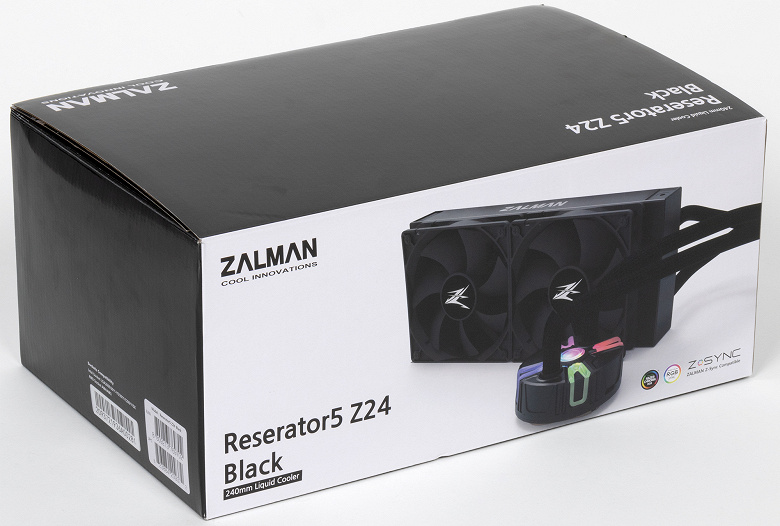
On the outer planes of the box, not only the product itself is depicted, but also some features are listed (with text and pictures), as well as technical specifications. The inscriptions are mostly in English, but the list of features is duplicated in several languages, including Russian.
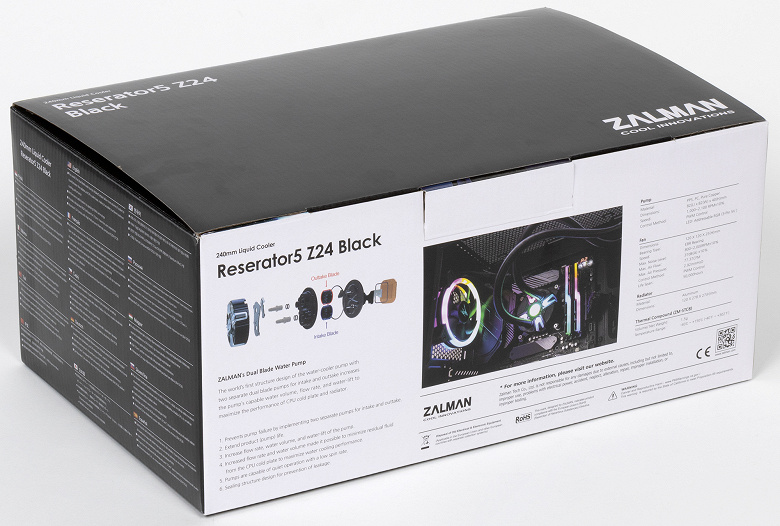
Papier-mâché molds, polyethylene foam padding, thin cardboard heatsink and fan covers, and plastic bags are used to protect and distribute parts. Accessories are packaged in bags and put in a cardboard box. The sole of the heat sink is protected by a plastic film.
Model LSS Zalman Reserator5 Z24 is available in two versions – black and white. Photos of the box that the black variant is packed in are shown above, and below is the package of this variant:
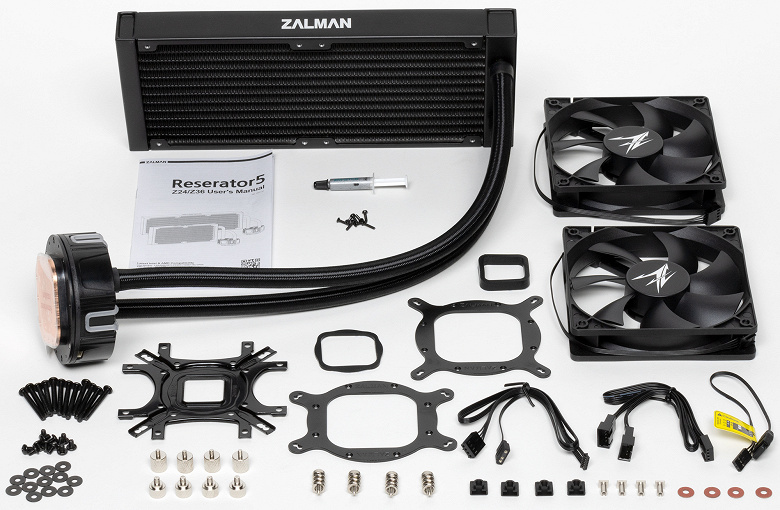
Box with white option:

And the matching kit:

It can be seen that in the case of the white version, the radiator cover, hose braid, the upper part of the water block housing, fans and cables from them are white, and a number of fasteners received a shiny metallic galvanized coating instead of black semi-gloss.
Good print quality instructions. The explanatory inscriptions are in English, but the instructions are mostly in pictures, so they are understandable without translation. The section with warnings is duplicated in several languages, including Russian. The company’s website has a full description of the cooler and a link to a PDF file with instructions.
The system is sealed, primed, and ready to use. The pump is integrated into one unit with a heat sink. The sole of the heat sink, directly adjacent to the processor cover, is a copper plate 2.5 mm thick. Its outer almost perfectly flat surface is ground and slightly polished.

The dimensions of this plate are 56×56 mm, and the internal part, limited by the screw holes, measures approximately 47×47 mm. Thermal paste in a small syringe, which, of course, is less convenient than a pre-applied layer. A complete supply of thermal paste should be enough for two times in the case of processors with a small cover area and at economical consumption. The tests used no less high-quality thermal paste from another manufacturer. Looking ahead, we will demonstrate the distribution of thermal paste after all tests are completed. On an Intel Core i9-7980XE processor:
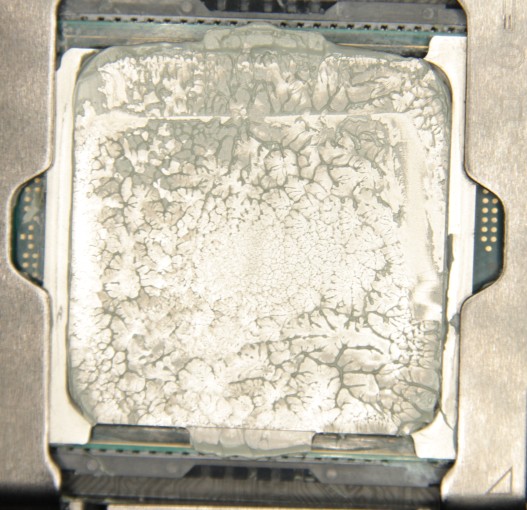
And on the sole of the water block:
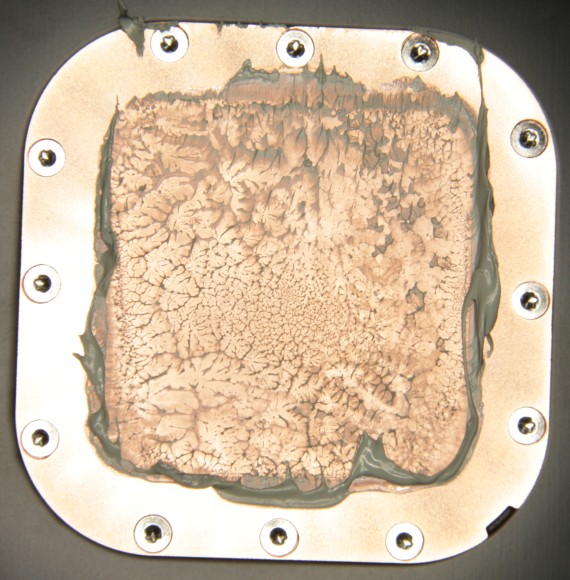
It can be seen that the thermal paste is distributed over the entire area of the processor cover, and approximately in the center there is a large area of u200bu200btight contact. Note that the cover of this processor itself is slightly convex towards the center.
And in the case of the AMD Ryzen 9 3950X processor. On processor:
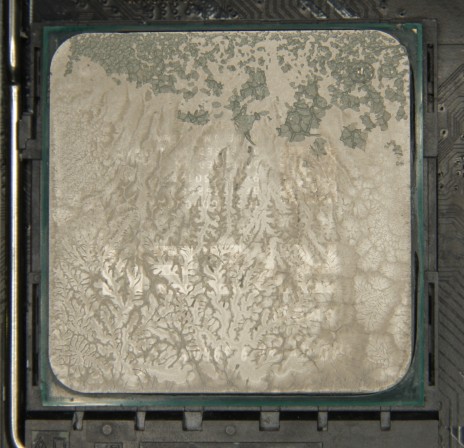
On the sole of the heat sink:
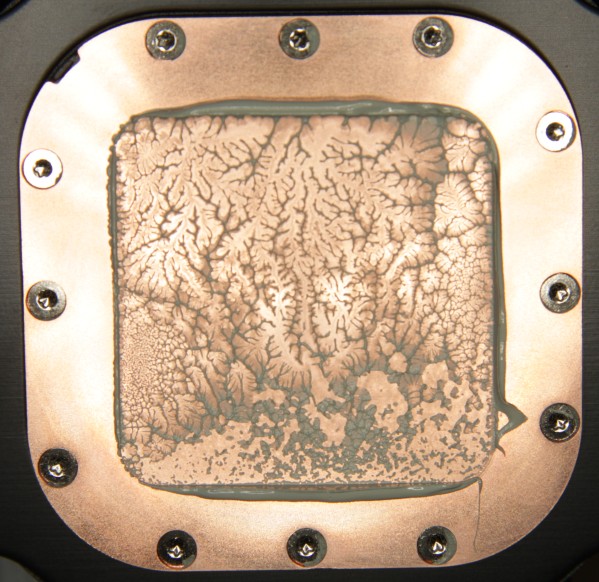
The dense contact area has a large area. (The thermal paste distribution, of course, changed slightly when the processor and pump were separated.)
The body of the water block is made of hard black plastic.
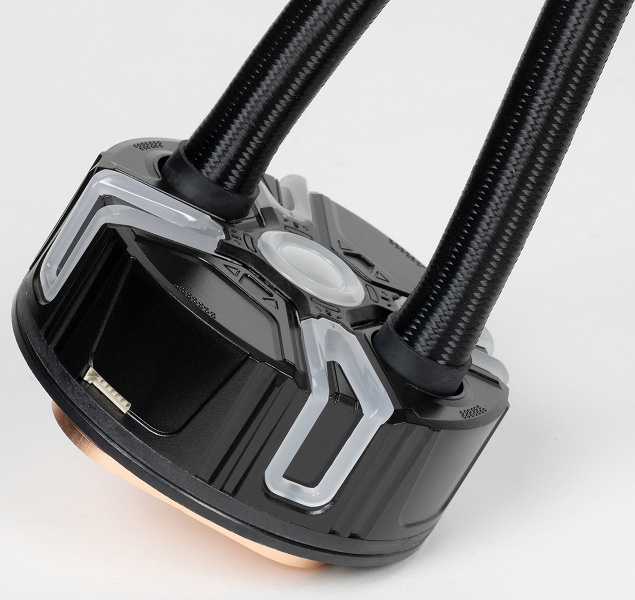
A casing (black or white) is fixed on top of the case, in which there are inserts made of white translucent plastic. Under the central round insert, you can see eight addressable RGB LEDs located in a circle. These LEDs are externally controlled via a 3-wire interface.
A feature of the pump is the use of two impellers, each driven by its own motor. One impeller works to enter the liquid into the heat exchanger chamber, the second – to the output. A exploded diagram, taken from the manufacturer’s website, explains the design of the pump.

The hoses are encased in a slippery synthetic sheath. Outer diameter of braided hoses approx. 13 mm. The fittings at the pump inlet rotate, which makes it easy to install the system.
The radiator is made of aluminum and has a black or white matte, relatively resistant coating on the outside.

Rubber pads are glued to the corners of the fan frame from the blowing side. These elastic elements should theoretically reduce vibration noise, but in practice this will not happen, since the mass of the fan and the rigidity of the vibration damping elements make it possible to reasonably assume that, due to the high resonant frequency, this system will not have any significant effect anyway. anti-vibration properties. In addition, the sockets on the other side, where the mounting screws are screwed, are part of the fan frame, so the vibration from the fan through the screws is transmitted without interference to the radiator. As a result, such an eye design can only be considered as a fan design element.
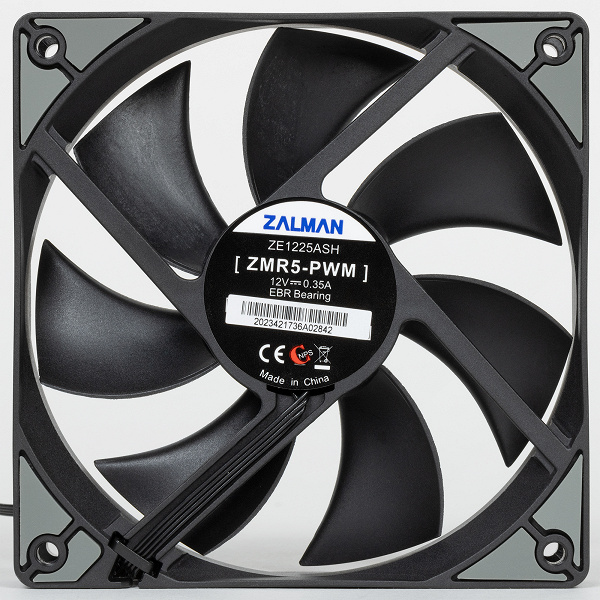
The fan has a four-pin connector at the end of the power cable.

The fasteners are made primarily from hardened steel and have a durable black semi-gloss paint finish or a high-gloss galvanized metal finish. We note the inconvenient mounting of the frame on the water block – it needs to be screwed with small screws (that is, you need another screwdriver) in the amount of eight pieces. The complete system with fasteners for LGA 2011 has a mass of 1604 g.
Testing
A full description of the testing methodology is given in the corresponding article ” Testing methodology for processor coolers of the 2020 sample “. For the load test, the powerMax (AVX) program was used, all cores of the Intel Core i9-7980XE processor worked at a fixed frequency of 3.2 GHz (multiplier 32).
Determination of the dependence of the cooler fan speed on the PWM duty cycle and / or supply voltage
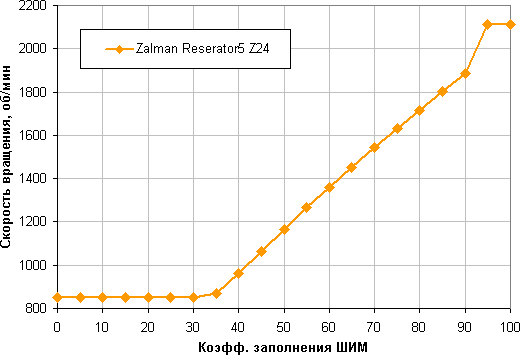
The rotation speed adjustment range is not very wide. There is a smooth, close to linear increase in the rotation speed with a change in the duty cycle (SC) from 35% to 95%. When the fill factor (SC) drops to 0, the fans do not stop. This may be of value if the user wants to create a hybrid cooling system that operates fully or partially in passive mode at low load.
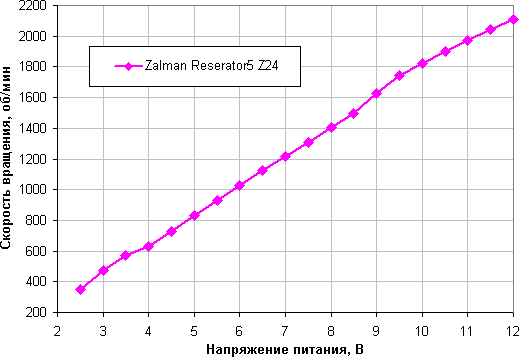
Changing the speed of rotation is also smooth, but the range of adjustment using voltage is much wider. The fans stop at 2.0, and start at 2.3-2.4 V. If necessary, they can be connected to 5 V. The pump rotation speed can also be controlled using PWM and supply voltage. Here are the corresponding graphs.

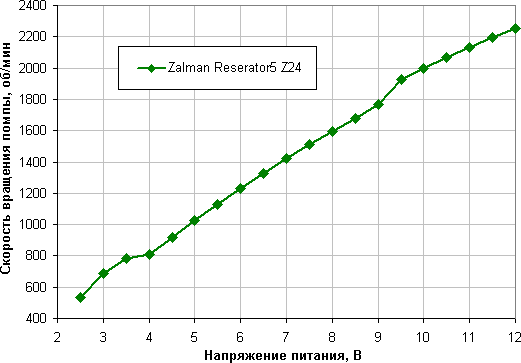
The pump stops at 1.9, and starts at 2.0 V, but the rotation sensor starts to work correctly at a slightly higher voltage. The pump can also be connected to 5 V.
Determination of the dependence of the temperature of the processor at its full load on the speed of rotation of the cooler fans
In the case of tests under load and when measuring the noise level, the rotational speed of the fans and the pump was changed using PWM when the short circuit changed in the range from 100% to 30% in 5% steps. For comparison, in the case of the Intel Core i9-7980XE processor, we tested both the black version and the white one. It is believed that the black coating of the radiator can slightly increase cooling efficiency by increasing heat radiation.
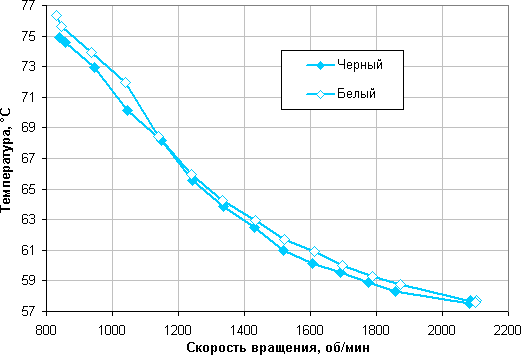
In this test, our 140W TDP processor does not overheat (at 24 degrees ambient) at fan speeds achieved with a short circuit reduction of up to 30%, which corresponds to approximately 830 rpm. The temperature in the case of the white version was slightly higher on average, but such a difference is quite within the range of error and variation between the samples, not due to the color of the radiator.
Determining the noise level depending on the speed of rotation of the cooler fans
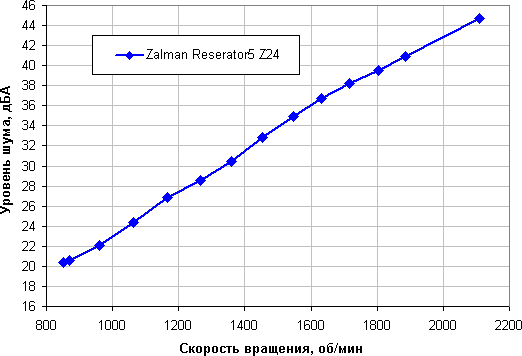
It depends, of course, on individual characteristics and other factors, but somewhere from 40 dBA and above, the noise is, from our point of view, very high for a desktop system; from 35 to 40 dBA, the noise level is classified as tolerable; below 35 dBA, the noise from the cooling system will not stand out much against the background of typical non-noisy PC components – case fans, fans on the power supply and on the video card, as well as hard drives; and somewhere below 25 dBA the cooler can be called conditionally silent. In this case, the entire specified range is covered, that is, depending on the speed of rotation of the fans and the pump, the system can be both noisy and very quiet. The background level was equal to 16.1 dBA (conditional value, which shows the sound level meter).
Plotting the dependence of the real maximum power on the noise level
Let’s try to get away from the conditions of the test bench to more realistic scenarios. Let’s say that the temperature of the air taken in by the cooling system fans can rise to 44 ° C (a realistic scenario when the fans on the radiator are set to blow out of the case in which the powerful video card is running), but the temperature of the processor under maximum load does not want to increase above 80 ° C. Restricting ourselves to these conditions, let’s plot the dependence of the real maximum power, denoted as P max (previously, we used the designation Max. TDP ), consumed by the processor, on the noise level ( details are described in the methodology ):

Taking 25 dBA as a conditional noiselessness criterion, we get the approximate maximum power of processors corresponding to this level, which is about 220 watts. If you do not pay attention to the noise level, the power limits can be increased somewhere up to 300 watts. Let us clarify once again that in harsh conditions of blowing the radiator with air heated to 44 degrees, when the air temperature drops, the indicated power limits for silent operation and maximum power increase.
Comparison with other LSS when cooling the Intel Core i9-7980XE processor
Using this link , you can calculate the power limits for other boundary conditions (air temperature and maximum processor temperature) and compare this system with several other LSSs tested using the same methodology (the list is updated). As you can see, the efficiency of this system in comparison with LSS equipped with a radiator for two 120 mm fans is average.
Testing on an AMD Ryzen 9 3950X processor
As an additional test, we decided to see how this coolant will cope with the cooling of the AMD Ryzen 9 3950X . The processors of the Ryzen 9 family are assemblies of three crystals under one cover. On the one hand, increasing the area from which heat is removed can improve the cooling capacity of the cooler, but on the other hand, the design of most coolers is optimized for better cooling of the central area of the processor. Only the black version of the LSS was included in this test.
The dependence of the temperature of the processor at its full load on the speed of rotation of the fans:

In fact, under test conditions, this processor does not overheat at 24 degrees of ambient air at a short circuit equal to 30%, which corresponds to about 830 rpm (for this CPU, heating up to 95 degrees is allowed).
Restricting ourselves to the above conditions, we plot the dependence of the real maximum power (denoted as P max ) consumed by the processor on the noise level:
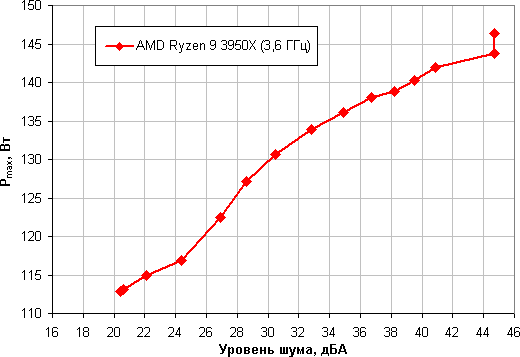
Taking 25 dBA as a conditional noiselessness criterion, we get that the maximum processor power corresponding to this level is about 118 W. If you do not pay attention to the noise level, then the power limit can be increased somewhere up to 145 watts. Once again, we will clarify: this is in harsh conditions of blowing the radiator with air heated to 44 degrees. As the air temperature drops, the specified power limits for quiet operation and maximum power increase. The result is noticeably worse than in the case of the Intel Core i9-7980XE processor. However, provided there is enough good ventilation in the case, this cooler will quite cope with the cooling of the AMD Ryzen 9 3950X processor, but you should not count on the possibility of significant overclocking.
Comparison with other coolers and coolers when cooling AMD Ryzen 9 3950X
You can use this link to calculate power limits for other boundary conditions (air temperature and maximum processor temperature). As can be seen, the efficiency of this system in the case of this processor is low.
findings
Based on the Zalman Reserator5 Z24 liquid cooling system, you can create a conditionally silent computer equipped with an Intel Core i9-7980XE (Intel LGA2066, Skylake-X (HCC)) type processor with a heat dissipation of about 220 W maximum, and this is even taking into account the possible increase in temperature inside the case up to 44 °C and subject to long-term maximum load. In the case of the AMD Ryzen 9 3950X chiplet processor, the cooler efficiency is noticeably lower, and in order to comply with the above conditions, the maximum power consumed by the processor should not exceed 118 watts. With lower cooling air temperatures and/or less stringent noise requirements, the power limits can be increased. Modding enthusiasts will appreciate the pump’s addressable multi-zone RGB lighting, which will help decorate the interior of the system unit. Note the pump control using PWM, which is not as common as we would like. You can choose from the classic black version, as well as white, with a white heatsink, water block and fans.
In conclusion, we suggest watching our video review of the Zalman Reserator5 Z24 liquid cooling system:
Our video review of the Zalman Reserator5 Z24 liquid cooling system can also be viewed at iXBT.video




